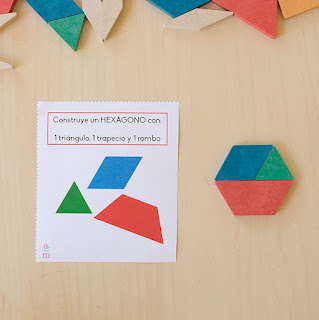Manipulative materials
Geometry, like other areas of mathematics, is most effectively and enjoyably learned by observing, touching and experimenting. Therefore, the best way for children to discover this exciting field is through manipulative geometry. There is a wealth of manipulative materials with which children can explore, deduce and learn the geometric properties of figures and bodies as well as internalise increasingly complicated geometric concepts. I believe that including them in the classroom can provide us with an impressive richness and encourage children's interest and meaningful learning.
Here is an example of a geometry manipulative material that has caught my attention:
Geometric blocks
This material consists of a set of flat figures with six different shapes: equilateral triangles, squares, hexagons, rhombuses (blue and grey) and trapezoids, each one in a different colour. They are versatile and we can create an infinite number of proposals with them. They can be adapted to all ages and children have a lot of fun playing with them freely. Moreover, they are easy to store at home or in the classroom and, to top it off, they are also beautiful and inexpensive.
With this complete material they can carry out various tasks such as getting to know plane figures and their elements (sides, vertices, diagonals and angles), discovering regularities and patterns (regular geometric figures and bodies, symmetries, mosaics, etc.), working on more advanced concepts such as perimeters and areas, solving geometry problems and challenges with closed and open proposals and also making free creations and thus developing their creativity.




Comentarios
Publicar un comentario